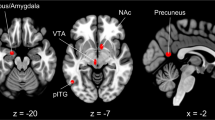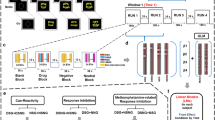Abstract
One known risk factor for drug use and abuse is sensitivity to rewarding effects of drugs. It is not known whether this risk factor extends to sensitivity to non-drug rewards. In this study with healthy young adults, we examined the association between sensitivity to the subjective rewarding effects of amphetamine and a neural indicator of anticipation of monetary reward. We hypothesized that greater euphorigenic response to amphetamine would be associated with greater neural activation to anticipation of monetary reward (Win > Loss). Healthy participants (N = 61) completed four laboratory sessions in which they received d-amphetamine (20 mg) and placebo in alternating order, providing self-report measures of euphoria and stimulation at regular intervals. At a separate visit 1–3 weeks later, participants completed the guessing reward task (GRT) during fMRI in a drug-free state. Participants reporting greater euphoria after amphetamine also exhibited greater neural activation during monetary reward anticipation in mesolimbic reward regions, including the bilateral caudate and putamen. This is the first study to show a relationship between neural correlates of monetary reward and sensitivity to the subjective rewarding effects of amphetamine in humans. These findings support growing evidence that sensitivity to reward in general is a risk factor for drug use and abuse, and suggest that sensitivity of drug-induced euphoria may reflect a general sensitivity to rewards. This may be an index of vulnerability for drug use or abuse.
Similar content being viewed by others
Log in or create a free account to read this content
Gain free access to this article, as well as selected content from this journal and more on nature.com
or
Notes
After extracting parameter estimates/β-weights from the peak activation, we found that one participant’s BOLD peak activation was an outlier (see Fig. 3b). Therefore, we re-ran the second-level model in SPM without this participant (n = 60) and the results remained significant.
In addition to including motion time series in the first-level GLM, we ran the second-level GLM with average framewise displacement for each participant as a covariate and the results remained significant.
References
NIDA (2017). Trends & Statistics. Retrieved from: https://www.drugabuse.gov/related-topics/trends-statistics.
Haertzen CA, Kocher TR, Miyasato K. Reinforcements from the first drug experience can predict later drug habits and/or addiction: results with coffee, cigarettes, alcohol, barbiturates, minor and major tranquilizers, stimulants, marijuana, hallucinogens, heroin, opiates and cocaine. Drug Alcohol Depend. 1983;11:147–65.
King AC, McNamara PJ, Hasin DS, Cao D. Alcohol challenge responses predict future alcohol use disorder symptoms: a 6-year prospective study. Biol Psychiatry. 2014;75:798–806.
Kollins SH, MacDonald EK, Rush CR. Assessing the abuse potential of methylphenidate in nonhuman and human subjects: a review. Pharmacol Biochem Behav. 2001;63:611–27.
Lambert NM, McLeod M, Schenk S. Subjective responses to initial experience with cocaine: an exploration of the incentive-sensitization theory of drug abuse. Addiction. 2006;101:713–25.
Quinn PD, Fromme K. Subjective response to alcohol challenge: a quantitative review. Alcohol Clin Exp Res. 2011;35:1759–70.
Rush CR, Essman WD, Simpson CA, Baker RW. Reinforcing and subject-rated effects of methylphenidate and d-amphetamine in non-drug-abusing humans. J Clin Psychopharmacol. 2001;21:273–86.
Volkow ND, Wang GJ, Fowler JS, Logan J, Gatley SJ, Wong C, Pappas NR. Reinforcing effects of psychostimulants in humans are associated with increases in brain dopamine and occupancy of D(2) receptors. J Pharmacol Exp Ther. 1999;291:409–15.
Davidson ES, Finch JF, Schenk S. Variability in subjective responses to cocaine: initial experiences of college students. Addict Behav. 1993;18:445–53.
de Wit H, Phillips TJ. Do initial responses to drugs predict future use or abuse? Neurosci Biobehav Rev. 2012;36:1565–76.
de Wit H, Uhlenhuth EH, Johanson CE. Individual differences in the reinforcing and subjective effects of amphetamine and diazepam. Drug Alcohol Depend. 1986;16:341–60.
Jasinski DR. History of abuse liability testing in humans. Br J Addict. 1991;86:1559–62.
Koob GF, Volkow ND. Neurobiology of addiction: a neurocircuitry analysis. Lancet Psychiatry. 2016;3:760–73.
Oswald LM, Wong DF, McCaul M, Zhou Y, Kuwabara H, Choi L, et al. Relationships among ventral striatal dopamine release, cortisol secretion, and subjective responses to amphetamine. Neuropsychopharmacology. 2005;30:821–32.
Abi-Dargham A, Kegeles LS, Martinez D, Innis RB, Laruelle M. Dopamine mediation of positive reinforcing effects of amphetamine in stimulant naive healthy volunteers: results from a large cohort. Eur Neuropsychopharmacol. 2003;13:459–68.
Leyton M, Boileau I, Benkelfat C, Diksic M, Baker G, Dagher A. Amphetamine-induced increases in extracellular dopamine, drug wanting, and novelty seeking: a PET/[11C]raclopride study in healthy men. Neuropsychopharmacology. 2002;27:1027–35.
Martinez D, Slifstein M, Broft A, Mawlawi O, Hwang DR, Huang Y, et al. Imaging human mesolimbic dopamine transmission with positron emission tomography. Part II: amphetamine-induced dopamine release in the functional subdivisions of the striatum. J Cereb Blood Flow Metab. 2003;23:285–300.
Volkow ND, Fowler JS, Wang GJ, Ding YS, Gatley SJ. Role of dopamine in the therapeutic and reinforcing effects of methylphenidate in humans: results from imaging studies. Eur Neuropsychopharmacol. 2002;12:557–66.
Drevets WC, Gautier C, Price JC, Kupfer DJ, Kinahan PE, Grace AA, et al. Amphetamine-induced dopamine release in human ventral striatum correlates with euphoria. Biol Psychiatry. 2001;49:81–96.
Haber SN, Knutson B. The reward circuit: linking primate anatomy and human imaging. Neuropsychopharmacology. 2010;35:4–26.
Weiland BJ, Zucker RA, Zubieta JK, Heitzeg MM (2017). Striatal dopaminergic reward response relates to age of first drunkenness and feedback response in at-risk youth. Addict Biol 22:502-512.
Hahn T, Dresler T, Ehlis AC, Plichta MM, Heinzel S, Polak T, et al. Neural response to reward anticipation is modulated by Gray’s impulsivity. Neuroimage. 2009;46:1148–53.
Cohen MX, Young J, Baek JM, Kessler C, Ranganath C. Individual differences in extraversion and dopamine genetics predict neural reward responses. Brain Res Cogn Brain Res. 2005;25:851–61.
Leyton M, Vezina P. Striatal ups and downs: their roles in vulnerability to addictions in humans. Neurosci Biobehav Rev. 2013;37:1999–2014.
Saunders BT, Robinson TE. Individual variation in resisting temptation: implications for addiction. Neurosci Biobehav Rev. 2013;37:1955–75.
Forbes EE, Hariri AR, Martin SL, Silk JS, Moyles DL, Fisher PM, et al. Altered striatal activation predicting real-world positive affect in adolescent major depressive disorder. Am J Psychiatry. 2009;166:64–73.
First M, Spitzer R, Gibbon M, Williams J. Structured Clinical Interview for DSM-IV® Axis I Disorders (SCID-I), Clinician Version, Administration Booklet (2002).
White TL, Justice AJ, de Wit H. Differential subjective effects of D-amphetamine by gender, hormone levels and menstrual cycle phase. Pharmacol Biochem Behav. 2002;73:729–41.
Martin WR, Sloan JW, Sapira JD, Jasinski DR. Physiologic, subjective, and behavioral effects of amphetamine, methamphetamine, ephedrine, phenmetrazine, and methylphenidate in man. Clin Pharmacol Ther. 1971;12:245–58.
Fischman MW, Foltin RW. Utility of subjective-effects measurements in assessing abuse liability of drugs in humans. Br J Addict. 1991;86:1563–70.
Mayo LM, de Wit H. Acquisition of responses to a methamphetamine-associated cue in healthy humans: self-report, behavioral, and psychophysiological measures. Neuropsychopharmacology. 2015;40:1734–41.
Forbes EE, Rodriguez EE, Musselman S, Narendran R. Prefrontal response and frontostriatal functional connectivity to monetary reward in abstinent alcohol-dependent young adults. PLoS ONE. 2014;9:e94640.
Foti D, Weinberg A, Dien J, Hajcak G. Event-related potential activity in the basal ganglia differentiates rewards from nonrewards: temporospatial principal components analysis and source localization of the feedback negativity. Hum Brain Mapp. 2011;32:2207–16.
Carlson JM, Foti D, Mujica-Parodi LR, Harmon-Jones E, Hajcak G. Ventral striatal and medial prefrontal BOLD activation is correlated with reward-related electrocortical activity: a combined ERP and fMRI study. Neuroimage. 2011;57:1608–16.
Proudfit GH. The reward positivity: from basic research on reward to a biomarker for depression. Psychophysiology. 2015;52:449–59.
Delgado MR, Nystrom LE, Fissell C, Noll DC, Fiez JA. Tracking the hemodynamic responses to reward and punishment in the striatum. J Neurophysiol. 2000;84:3072–7.
Rhodes JD, Hawk LW Jr. Smoke and mirrors: the overnight abstinence paradigm as an index of disrupted cognitive function. Psychopharmacology. 2016;233:1395–404.
Yarkoni T, Poldrack RA, Nichols TE, Van Essen DC, Wager TD. Large-scale automated synthesis of human functional neuroimaging data. Nat Methods. 2011;8:665–70.
Cox RW. AFNI: software for analysis and visualization of functional magnetic resonance neuroimages. Comput Biomed Res. 1996;29:162–73.
Weafer J, Gorka SM, Hedeker D, Dzemidzic M, Kareken DA, Phan KL, et al. Associations between behavioral and neural correlates of inhibitory control and amphetamine reward sensitivity. Neuropsychopharmacology. 2017a;42:1905–13.
Weafer J, Lyon N, Hedeker D, de Wit H. Sweet taste liking is associated with subjective response to amphetamine in women but not men. Psychopharmacology. 2017b;234:3185–94.
Funding
This publication was funded by the National Institute on Drug Abuse (NIDA) (R01DA002812, PIs: H.d.W. and K.L.P.). S.M.G. was supported by the National Institute on Alcohol Abuse and Alcoholism (NIAAA) (K23AA025111, PI: S.M.G.) and J.W. was supported by NIAAA (K01AA024519, PI: J.W.). Its contents are solely the responsibility of the authors and do not necessarily represent the official views of NIDA, NIAAA, or the National Institutes of Health.
Author information
Authors and Affiliations
Corresponding author
Ethics declarations
Competing interests
H.d.W. received consulting fees from Jazz Pharmaceuticals, research support in the form of a GRAND award from Pfizer, support for a research study from Insys Therapeutics, and a donation of a research drug from Indivior. None of these were related to the research reported here. All the other authors declare no competing interests.
Rights and permissions
About this article
Cite this article
Crane, N.A., Gorka, S.M., Weafer, J. et al. Neural activation to monetary reward is associated with amphetamine reward sensitivity. Neuropsychopharmacol 43, 1738–1744 (2018). https://doi.org/10.1038/s41386-018-0042-8
Received:
Revised:
Accepted:
Published:
Issue date:
DOI: https://doi.org/10.1038/s41386-018-0042-8
This article is cited by
-
Effects of methamphetamine on two measures of reward: Euphoria and neural activation to reward cues
Neuropsychopharmacology (2025)
-
The mesocorticolimbic system in stimulant use disorder
Molecular Psychiatry (2025)
-
Lack of effect of methamphetamine on reward-related brain activity in healthy adults
Psychopharmacology (2024)
-
Methamphetamine alters nucleus accumbens neural activation to monetary loss in healthy young adults
Psychopharmacology (2023)
-
Embodied decision biases: individually stable across different tasks?
Experimental Brain Research (2023)



